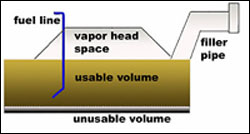Why ’filling-it-up’ takes more than ’tank capacity’

Simplified schematic of a vehicle fuel tank (not to scale). Credit: J.Williams/NIST
You fill up your “empty” fuel tank at the gas station and the pump charges you for more gallons than the tank’s rated capacity. Are you being deliberately overcharged?
Unauthorized tampering with pumps does happen, even though state and local weights and measures officials regularly check gasoline pumps to ensure their accuracy. But there are also legitimate reasons for a discrepancy between the amount of fuel metered by a gas pump and an automobile’s rated fuel tank capacity, according to a recent paper from the National Institute of Standards and Technology (NIST).
For example, some manufacturers estimate that actual fuel tank capacity can vary as much as 3 percent from the tank capacity rating because of design characteristics, the manufacturing process, and even the physics associated with the components that monitor emissions and the electronics of the fuel system and fuel indicators.
NIST notes that it is important to consider which parts of a vehicle’s fuel tank are used to determine its capacity rating and what happens to these components when operating and fueling a vehicle. A small area at the bottom of a full tank is considered unusable because the fuel pump cannot reach that level to draw fuel. In addition, the tank’s rated capacity does not include the “vapor head space,” the uppermost portion of the tank compartment, nor does it include the volume of the filler pipe where fuel enters the vehicle.
Drivers, however, sometimes fill the tank beyond the pump’s automatic shut-off point, resulting in fuel being drawn into the vehicle’s vapor recovery system or filler pipe. Similarly, if the lanes that surround the service station pumps are not level, fuel can shift into the vapor space allowing more fuel to be delivered into the tank.
NIST cautions against using the “half full” reading on the fuel gauge to determine the exact number of gallons it will take to fill the tank. The fuel gauge is intended as an approximate indication of the fuel level. Manufacturers may set the “full” indicator at a level just below the tank’s actual capacity. Reserve fuel also can be present if the manufacturer designs the fuel gauge to indicate empty at a level above the actual point where the tank runs out of gas.
Media Contact
All latest news from the category: Power and Electrical Engineering
This topic covers issues related to energy generation, conversion, transportation and consumption and how the industry is addressing the challenge of energy efficiency in general.
innovations-report provides in-depth and informative reports and articles on subjects ranging from wind energy, fuel cell technology, solar energy, geothermal energy, petroleum, gas, nuclear engineering, alternative energy and energy efficiency to fusion, hydrogen and superconductor technologies.
Newest articles

Parallel Paths: Understanding Malaria Resistance in Chimpanzees and Humans
The closest relatives of humans adapt genetically to habitats and infections Survival of the Fittest: Genetic Adaptations Uncovered in Chimpanzees Görlitz, 10.01.2025. Chimpanzees have genetic adaptations that help them survive…

You are What You Eat—Stanford Study Links Fiber to Anti-Cancer Gene Modulation
The Fiber Gap: A Growing Concern in American Diets Fiber is well known to be an important part of a healthy diet, yet less than 10% of Americans eat the minimum recommended…

Trust Your Gut—RNA-Protein Discovery for Better Immunity
HIRI researchers uncover control mechanisms of polysaccharide utilization in Bacteroides thetaiotaomicron. Researchers at the Helmholtz Institute for RNA-based Infection Research (HIRI) and the Julius-Maximilians-Universität (JMU) in Würzburg have identified a…



